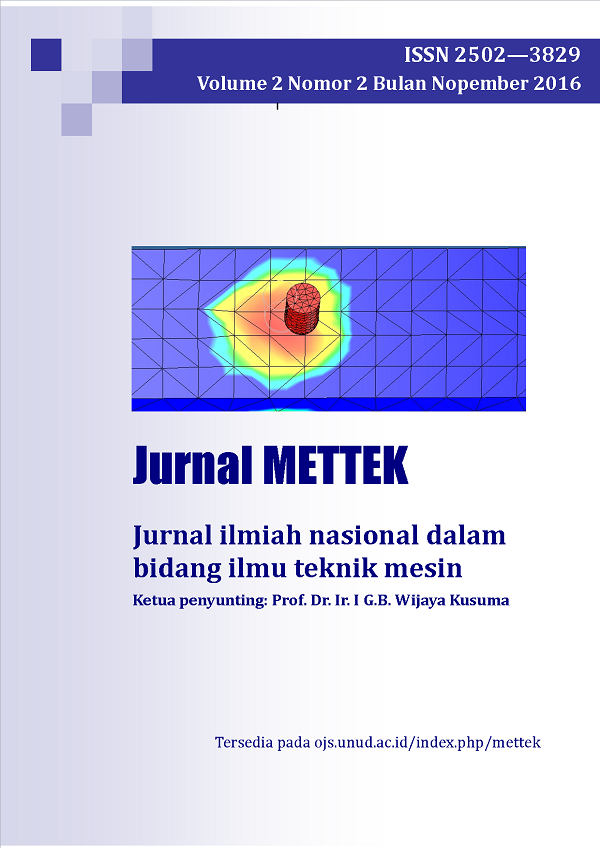ANALISA CACAT DRILLING DARI MATERIAL HYBRID KOMPOSIT LAMINASI SERAT KARBON-BASALT-EPOXY
Abstract
Proses permesinan pada mesin perkakas merupakan salah satu jenis proses pembuatan komponen benda kerja. Salah satu proses pemotongan bahan adalah proses drilling. Penelitian ini dilakukan adalah untuk mengamati cacat pada material komposit akibat drilling proses. Material komposit dengan laminasi serat penguat karbon dan basalt telah digunakan. Tujuan penelitian adalah untuk mengetahui pengaruh drilling terhadap cacat pinggir yang terjadi pada hybrid komposit. Metode penelitian yang digunakan adalah metode penelitian eksperimental. Variasi ukuran pahat potong adalah berdiameter 8 mm dan 10 mm. Proses permesinan dilakukan dengan kondisi pemotongan dry process dan wet process. Hasil proses permesinan drilling akan diinvestigasi dengan scanning electron microscope (SEM) dan analisa data menggunakan software computer ImageJ. Hasil penelitian menunjukkan bahwa : (1) kenaikan mata bor tidak signifikan memberikan pengaruh nilai stress area yang terbentuk; (2) temperatur pemotongan akibat gesekan antara mata bor dengan permukaan material memberikan pengaruh terhadap nilai stress area sebelum material tersebut terdeformasi, hal ini kondisi pemotongan yang sangat berperan.
The machining process is one type in work piece processing using a machine tool. The drilling was wide process in cutting work piece. This research was done to investigate the defect of composite materials against drilling process. Hybrid composite material with lamination carbon fiber and basalt fiber reinforced was carried out. The aim is to investigate the edge defect of hybrid composite against the drilling process. The experiment method was conducted in this research. The drill bit variation was used in diameter 8mm and 10mm. The machining process was conducted on dry and wet condition. The results of drilling machining process have been investigated by scanning electron microscope (SEM) and analyzed using Image J software. The results showed that: (1) a significant increase in the drill bit does not give effect to stress the value of the area; (2) cutting temperature due to friction between the drill bit to the surface of the material to give effect to stress the value of the area before the material is deformed, it is very instrumental cutting conditions.
Downloads
References
Idg Ary Subagia, and Yonjig Kim, 2013, A study on flexural properties of carbon-basalt/epoxy hybrid composites, Journal of Mechanical Science and Technology, vol. 27, no. 4, pp. 987-992.
Se Artemenko, and Yu A Kadykova, 2008, Hybrid composite materials, Fibre chemistry, vol. 40, no. 6, pp. 490-492.
Idg Ary Subagia, Yonjig Kim, Leonard D Tijing, Cheol Sang Kim, and Ho Kyong Shon, 2014, Effect of stacking sequence on the flexural properties of hybrid composites reinforced with carbon and basalt fibers, Composites Part B: Engineering, vol. 58, pp. 251-258.
F Sarasini, J Tirillò, L Ferrante, M Valente, T Valente, L Lampani, P Gaudenzi, S Cioffi, S Iannace, and L Sorrentino, 2014, Drop-weight impact behaviour of woven hybrid basalt–carbon/epoxy composites, Composites Part B: Engineering, vol. 59, pp. 204-220.
Tamás Deák, and Tibor Czigány, 2009, Chemical composition and mechanical properties of basalt and glass fibers: A comparison, Textile Research Journal, vol. 79, no. 7, pp. 645-651.
Vivek Dhand, Garima Mittal, Kyong Yop Rhee, Soo-Jin Park, and David Hui, 2015, A short review on basalt fiber reinforced polymer composites, Composites Part B: Engineering, vol. 73, pp. 166-180.
Roberto Teti, 2002, Machining of composite materials, CIRP Annals-Manufacturing Technology, vol. 51, no. 2, pp. 611-634.
Defu Liu, Yongjun Tang, and Wl Cong, 2012, A review of mechanical drilling for composite laminates, Composite Structures, vol. 94, no. 4, pp. 1265-1279.
B Murthy, Ll Rodrigues, and Anjaiah Devineni, 2012, Process parameters optimization in gfrp drilling through integration of taguchi and response surface methodology, Research Journal of Recent Sciences ISSN, vol. 2277, pp. 2502.
Navid Zarif Karimi, Hossein Heidary, Giangiacomo Minak, and Mehdi Ahmadi, 2013, Effect of the drilling process on the compression behavior of glass/epoxy laminates, Composite Structures, vol. 98, pp. 59-68.
M Saleem, L Toubal, R Zitoune, and H Bougherara, 2013, Investigating the effect of machining processes on the mechanical behavior of composite plates with circular holes, Composites Part A: Applied Science and Manufacturing, vol. 55, pp. 169-177.
Amrinder Pal Singh, Manu Sharma, and Inderdeep Singh, 2013, A review of modeling and control during drilling of fiber reinforced plastic composites, Composites Part B: Engineering, vol. 47, pp. 118-125.
Ozden Isbilir, and Elaheh Ghassemieh, 2013, Numerical investigation of the effects of drill geometry on drilling induced delamination of carbon fiber reinforced composites, Composite Structures, vol. 105, pp. 126-133.
Xu Wang, Yan Li He, and Jing Yi Wang, 2013, A delamination factor prediction model for drilling of composite materials. pp. 41-45.
Kv Krishna Sastry, V Seshagiri Rao, K Palanikumar, R Dhanalakshmi, and Abhishek Kuravi, 2014, Assessment of process parameters influencing delamination factor on the drilling of cfrc composite material with tin coated carbide tool, Indian journal of science and technology, vol. 7, no. 2, pp. 142-150.
Nanya Li, Yingguang Li, Jing Zhou, Yongxi He, and Xiaozhong Hao, 2015, Drilling delamination and thermal damage of carbon nanotube/carbon fiber reinforced epoxy composites processed by microwave curing, International Journal of Machine Tools and Manufacture, vol. 97, pp. 11-17.
Bin Luo, Yuan Li, Kaifu Zhang, Hui Cheng, and Shunuan Liu, 2016, Effect of workpiece stiffness on thrust force and delamination in drilling thin composite laminates, Journal of Composite Materials, vol. 50, no. 5, pp. 617-625.
Luís Miguel P Durão, João Manuel Rs Tavares, Victor Hugo C De Albuquerque, Jorge Filipe S Marques, and Oscar Ng Andrade, 2014, Drilling damage in composite material, Materials, vol. 7, no. 5, pp. 3802-3819.
Pierre Rahme, Yann Landon, Robert Piquet, Frederic Lachaud, and Pierre Lagarrigue, 2016, Drilling analytical model of composite material with pilot hole, Mechanics & Industry, vol. 17, no. 5, pp. 513.
Keywords

This work is licensed under a Creative Commons Attribution-NonCommercial-ShareAlike 4.0 International License.







